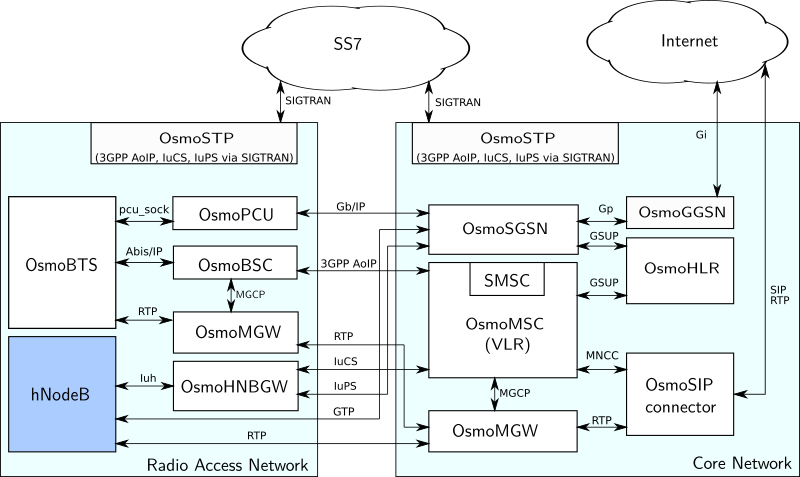Until 2009 the situation looked like this:
In 2008, some people (most present in this room) started to write FOSS for GSM
bs11-abis to bsc_hack to OpenBSC
Mobile Station (your phone)
Base Transceiver Station, consists of 1..n TRX
Transceiver for one radio channel, serves 8 TS
Timeslots in the GSM radio interface; each runs a specific combination of logical channels
Base Station Controller
Mobile Switching Center; Terminates MM + CC Sub-layers
Home Location Register; Subscriber Database
SMS Service Center
Link Access Protocol, D-Channel. Like LAPD in ISDN
Radio Resource (establish/release dedicated channels)
Mobility Management (registration, location, authentication)
Call Control (voice, circuit switched data, fax)
Connection Management



We assume a sysmoBTS in the following tutorial
osmo-bts-sysmo: BTS family by sysmocom
osmo-bts-trx: Used with OsmoTRX + general-purpose SDR
osmo-bts-octphy: Octasic OCTBTS hardware / OCTSDR-2G PHY
osmo-bts-litecell15: Nutaq Litecell 1.5 hardware/PHY
See separate talk about BTS hardware options later today.




⇒ Make sure you permit the above communication in your network/firewall config
configure terminal and interactively change it
/etc/osmocom/osmo-bts.cfg as
described in the following slide
bts 0
band DCS1800 <1>
ipa unit-id 1801 0 <2>
oml remote-ip 192.168.100.11 <3>the GSM frequency band in which the BTS operates
the unit-id by which this BTS identifies itself to the BSC
the IP address of the BSC (to establish the OML connection towards it)
|
Note
|
All other configuration is downloaded by the BSC via OML. So most BTS settings are configured in the BSC/NITB configuration file. |

⇒ BSC identifies BTS on Unit ID, not on Source IP!
git clone && autoreconf -fi && ./configure && make install
libosmo* dependencies are required first…)
doc/examples/osmo-*.cfg of each git repo
→ let’s check if we can perform LOCATION UPDATE on our own network
logging level mm info
→ should show LOCATION UPDATE request / reject / accept
show *)
*#100# from any registered MS to obtain own number
show commands)
Program |
Telnet Port |
OsmoBTS |
4241 |
OsmoBSC |
4242 |
OsmoMSC |
4254 |
OsmoHLR |
4258 |
? and list commands
show commands to introspect
show bts, show trx, show lchan, show statistics, …
enable + configure terminal for configuration mode
logging enable adds log target to VTY session
See https://osmocom.org/projects/cellular-infrastructure/wiki